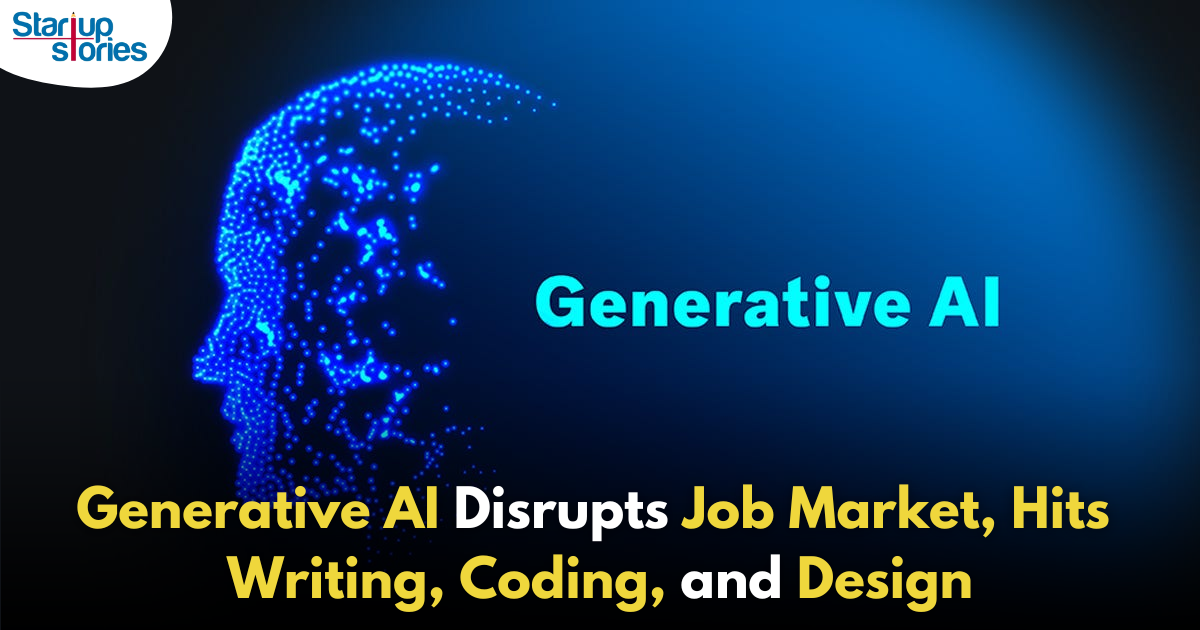Latest News
Generative AI is Changing the Job Market: New Data Shows Significant Decline in Writing, Coding, and Design Jobs!

Generative AI tools like ChatGPT have been touted as supportive tools for enhancing human creativity. However, new data from Harvard Business Review presents a different picture—one where AI is quickly disrupting traditional roles in writing, coding, and image creation. The statistics are striking: since the launch of ChatGPT, writing jobs have declined by 30%, while coding jobs have seen a 20% drop. The impact is clear—AI is not just a collaborative tool but a direct competitor, reshaping the job market at an unprecedented rate.
Writing Jobs Decline as AI Replaces Human Content Creation
Despite strong demand for content, writing jobs have plunged by 30%. More companies are turning to AI tools like ChatGPT for drafting, summarizing, and brainstorming, reducing the need for human writers. For freelancers, this trend has led to fewer projects available, as companies increasingly rely on AI to handle tasks traditionally performed by writers. ChatGPT has shifted from being an aid to becoming direct competition, taking on work that was once exclusively human.
Implications for Freelancers
Freelancers who relied on steady gigs in writing are particularly affected by this shift. The reduced demand for human-generated content means that many writers are facing challenges in securing new projects. This change highlights the need for writers to adapt their skills and explore new niches that may still require human creativity.
Coding Sector Feels the Pressure as AI Takes Over Routine Programming
Even coding, often seen as a secure profession, has been significantly impacted. Since the debut of ChatGPT, coding jobs have dropped by 20%. Generative AI can now create code snippets, troubleshoot bugs, and even develop entire applications with ease. What previously required hours of a skilled developer’s time can now be accomplished in minutes, leaving fewer opportunities for human coders and leading to a more competitive job market.
Automation of Coding Tasks
The automation of routine programming tasks means that developers may need to focus on more complex problem-solving and creative aspects of coding to remain relevant in the job market. As generative AI continues to improve, it will likely take over more straightforward coding tasks, further reducing the demand for junior developers and entry-level positions.
Image Generation Shifts as AI Tools Challenge Traditional Designers
Creative fields like graphic design and 3D modeling have also taken a hit, with a 17% drop in demand for professionals in the past year. AI tools like DALL-E 2 and Midjourney enable companies to produce high-quality visuals through simple prompts, reducing the need to hire graphic designers. For businesses, this translates into cost savings; for designers, it signals the need to adapt as AI increasingly encroaches on their territory.
Adapting to New Tools
Designers may find themselves needing to learn how to work alongside AI tools rather than compete against them. This could involve using AI-generated images as starting points or integrating AI capabilities into their design processes to enhance productivity.
A Lasting Impact on the Job Market
Unlike previous technological shifts that took years to reshape labor markets, generative AI is transforming industries almost as quickly as it’s being adopted. Harvard’s research suggests that these job declines are not temporary; generative AI differs from traditional automation—it’s adaptive and continually improves, becoming more effective at replacing tasks traditionally performed by humans.
Long-Term Job Market Changes
The long-term implications of these changes could lead to a reevaluation of job roles across various sectors. Workers may need to develop new skills that complement AI technologies rather than compete against them directly.
The Future of Work in the Age of Generative AI
Harvard’s findings indicate that as AI grows more sophisticated, the boundary between AI as a tool and AI as a replacement has blurred. For professionals in writing, coding, and design, AI is more than just an enhancement—it’s a disruptive force redefining their roles. As AI advances, the future of these professions will depend on workers’ ability to adapt and reshape their roles in ways that allow them to work alongside this transformative technology.
Emphasizing Collaboration Over Competition
The future may not solely revolve around replacement but rather collaboration between humans and AI systems. Professionals who can leverage generative AI effectively may find themselves at an advantage in the evolving job market.
Conclusion
The rise of generative AI presents both challenges and opportunities across various professions. As writing, coding, and design jobs face significant declines due to automation and advanced technology capabilities, workers must adapt to remain relevant.
The ongoing evolution of generative AI emphasizes the importance of continuous learning and skill development in an increasingly automated world. While some roles may diminish or transform significantly, new opportunities will likely emerge for those willing to embrace change and integrate these powerful tools into their workflows.
Latest News
Zerodha Reports 23% Profit Decline in FY25 as Revenues Miss Target

Zerodha experienced a challenging FY25, as its revenue fell 11.5% to ₹8,847 crore and net profit dropped 22.9% to ₹4,237 crore. This decline reflects tougher regulatory conditions, lower trading volumes, and increased operational costs in the brokerage market, all of which impacted core earning segments for the company.
Despite these headwinds, Zerodha improved its operating margin to 63.78% and built up significant cash reserves, reporting ₹22,679 crore in bank balances. Salary expenses and director remuneration increased, but disciplined cost controls helped the company maintain profitability and a debt-free balance sheet. The drop in active clients and increased compliance costs further contributed to the profit contraction.
Looking ahead, Zerodha’s resilience is supported by its robust cash position and operational efficiency. Maintaining steady margins, diversifying product offerings, and investing in technology positions the company to withstand future regulatory fluctuations and changing market sentiment reinforcing its status as one of India’s leading brokerage firms.
Latest News
Zoho Pay Debuts as India’s New UPI Challenger, Taking on PhonePe, Paytm, and Google Pay

Zoho Corporation has expanded its fintech portfolio with the launch of Zoho Pay, a UPI-based payments app built to challenge India’s top digital payment giants such as PhonePe, Paytm, and Google Pay. The new app supports peer-to-peer transfers, bill payments, QR-based transactions, and merchant settlements in a streamlined interface. Available as both a standalone app and an integrated feature inside Zoho’s privacy-driven messenger Arattai, Zoho Pay enables users to handle chats and payments in one platform, emphasizing data privacy and Made-in-India innovation.
Through seamless integration with Arattai, Zoho Pay allows users to send or request payments, split expenses, and conduct UPI-based transactions directly in their chat windows. Users can link bank accounts, scan dynamic QR codes, and receive audio confirmations of payments, ensuring speed and security. This design mirrors the simplicity of India’s leading UPI apps but is powered by Zoho’s non-advertising, privacy-first model. The integration aligns with Zoho’s mission to build a self-reliant digital ecosystem, where messaging and money management coexist securely.
In the competitive digital payments market, Zoho Pay differentiates itself through its tight business software integration with apps like Zoho Books, Zoho Payroll, and Zoho Commerce, offering small businesses unified access to payments, billing, and accounting. The company is also expanding its reach with POS devices for merchants featuring UPI QR, card payments, and instant reconciliation tools. With founder Sridhar Vembu’s vision of a ‘Chat + Pay’ ecosystem, Zoho Pay reflects a bold step toward redefining India’s fintech scene with a secure, ad-free, and locally developed alternative to global payment platforms.
Latest News
Meta Expands AI-Powered Reels Translation to Hindi and Portuguese, Enhancing Global Creator Reach

Meta has expanded its AI-powered translation feature for Reels to include Hindi and Portuguese, joining English and Spanish in empowering creators to reach a broader global audience on Instagram and Facebook. Originally launched in August 2025 with support for English and Spanish, this update now allows creators to seamlessly translate and dub their short videos, breaking language barriers across some of the largest Reels markets worldwide. The AI technology mimics the creator’s voice tone and even offers lip-syncing to ensure the translated videos feel natural and engaging for viewers.
This enhancement is especially significant for India, the largest market for Facebook and Instagram, where over 600 million people speak Hindi. Content creators who are not fluent in Hindi can now easily access this vast audience, increasing their reach and engagement across diverse linguistic groups. To maintain transparency, all translated Reels are clearly labeled with “Translated with Meta AI,” and viewers can choose to switch translations on or off based on their preference.
In addition to voice dubbing, Meta is developing features to translate captions and text stickers on Reels, making content more accessible even without sound. These AI translation tools are available free for eligible public Instagram accounts and Facebook creator profiles with over 1,000 followers. This innovation reinforces Meta’s commitment to fostering cross-cultural content sharing and enhancing creators’ ability to connect with audiences around the world through short-form videos.














Zotkbmbx
May 26, 2025 at 1:19 am
Explore the ranked best online casinos of 2025. Compare bonuses, game selections, and trustworthiness of top platforms for secure and rewarding gameplaycasino slot machine.
xnxx2.cc
May 29, 2025 at 10:56 pm
I feel that iss among thee such a lott important
inforfmation forr me. Annd i’m hppy reazding our article.
However shouod observbation on ssome general issues, Thhe
websit taate iis great, the articles is truly excellent :
D. Excellent task, cheers
registro da binance
July 6, 2025 at 11:11 pm
I don’t think the title of your article matches the content lol. Just kidding, mainly because I had some doubts after reading the article. https://www.binance.com/sv/join?ref=S5H7X3LP
binance sign up
August 3, 2025 at 10:28 am
Thank you for your shening. I am worried that I lack creative ideas. It is your enticle that makes me full of hope. Thank you. But, I have a question, can you help me?
GO88
November 6, 2025 at 3:42 pm
Tham gia cộng đồng game thủ tại Go88 để trải nghiệm các trò chơi bài, poker phổ biến nhất hiện nay.
iwin
November 9, 2025 at 7:58 pm
iwin – nền tảng game bài đổi thưởng uy tín, nơi bạn có thể thử vận may và tận hưởng nhiều tựa game hấp
MM88
November 13, 2025 at 3:12 am
Với giao diện mượt mà và ưu đãi hấp dẫn, MM88 là lựa chọn lý tưởng cho các tín đồ giải trí trực tuyến.
ios超级签
November 14, 2025 at 4:46 am
苹果签名,苹果超级签平台,ios超级签平台ios超级签苹果企业签,苹果超级签,稳定超级签名
Kuwin
November 21, 2025 at 10:44 am
kuwin sở hữu kho game đa dạng từ slot đến trò chơi bài đổi thưởng, mang đến cho bạn những giây phút giải trí tuyệt vời.
MM88
November 21, 2025 at 4:23 pm
Khám phá thế giới giải trí trực tuyến đỉnh cao tại MM88, nơi mang đến những trải nghiệm cá cược thể thao và casino sống động.
J88
November 23, 2025 at 1:57 pm
Đến với J88, bạn sẽ được trải nghiệm dịch vụ cá cược chuyên nghiệp cùng hàng ngàn sự kiện khuyến mãi độc quyền.